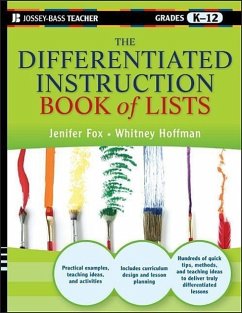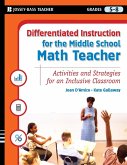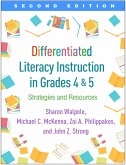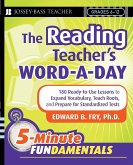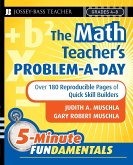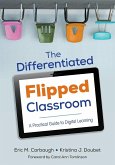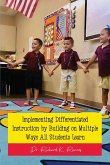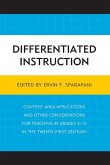28,99 €
inkl. MwSt.
Versandfertig in über 4 Wochen

14 °P sammeln
- Broschiertes Buch
- Merkliste
- Auf die Merkliste
- Bewerten Bewerten
- Teilen
- Produkt teilen
- Produkterinnerung
- Produkterinnerung
THE DIFFERENTIATED INSTRUCTION BOOK of LISTS Differentiated Instruction (DI) puts the focus on student activity rather than direct teacher instruction. In differentiated classrooms, students are doing things like moving around the room to learning stations, leading discussions, giving presentations, and working on teams to solve creative problems. These involved students are highly invested in learning and are given a wide variety of opportunities to succeed. The Differentiated Instruction Book of Lists is the definitive reference for Differentiated Instruction for teachers in grades K-12.…mehr
Andere Kunden interessierten sich auch für
![Differentiated Instruction for the Middle School Math Teacher Differentiated Instruction for the Middle School Math Teacher]() Karen E D'AmicoDifferentiated Instruction for the Middle School Math Teacher26,99 €
Karen E D'AmicoDifferentiated Instruction for the Middle School Math Teacher26,99 €![Differentiated Literacy Instruction in Grades 4 and 5 Differentiated Literacy Instruction in Grades 4 and 5]() Sharon WalpoleDifferentiated Literacy Instruction in Grades 4 and 566,99 €
Sharon WalpoleDifferentiated Literacy Instruction in Grades 4 and 566,99 €![The Reading Teacher's Word-A-Day Grades 6-12 The Reading Teacher's Word-A-Day Grades 6-12]() Edward B FryThe Reading Teacher's Word-A-Day Grades 6-1220,99 €
Edward B FryThe Reading Teacher's Word-A-Day Grades 6-1220,99 €![The Math Teacher's Problem-A-Day Grades 4-8 The Math Teacher's Problem-A-Day Grades 4-8]() Judith A MuschlaThe Math Teacher's Problem-A-Day Grades 4-819,99 €
Judith A MuschlaThe Math Teacher's Problem-A-Day Grades 4-819,99 €![The Differentiated Flipped Classroom The Differentiated Flipped Classroom]() Eric M. CarbaughThe Differentiated Flipped Classroom30,99 €
Eric M. CarbaughThe Differentiated Flipped Classroom30,99 €![Implementing Differentiated Instruction by Building on Multiple Ways All Students Learn Implementing Differentiated Instruction by Building on Multiple Ways All Students Learn]() Richard K. RamosImplementing Differentiated Instruction by Building on Multiple Ways All Students Learn13,99 €
Richard K. RamosImplementing Differentiated Instruction by Building on Multiple Ways All Students Learn13,99 €![Differentiated Instruction Differentiated Instruction]() Differentiated Instruction62,99 €
Differentiated Instruction62,99 €-
-
-
THE DIFFERENTIATED INSTRUCTION BOOK of LISTS Differentiated Instruction (DI) puts the focus on student activity rather than direct teacher instruction. In differentiated classrooms, students are doing things like moving around the room to learning stations, leading discussions, giving presentations, and working on teams to solve creative problems. These involved students are highly invested in learning and are given a wide variety of opportunities to succeed. The Differentiated Instruction Book of Lists is the definitive reference for Differentiated Instruction for teachers in grades K-12. Ready for immediate use, this handy resource includes more than 150 up-to-date lists for developing instructional materials, planning lessons, and assessing students. Written by two experts on the topic, the book is filled with practical examples, proven teaching ideas, and engaging activities that can be used or adapted to meet the wide range of students' individual needs. Authors Jenifer Fox and Whitney Hoffman show how to: * Teach with the individual in mind * Plan a differentiated curriculum * Create strategies for differentiating language arts, math, science, social studies, art, physical education, and health * Employ commonly used DI techniques for various grade levels * Develop DI classroom management skills * Tap into new media strategies that naturally differentiate instruction With this hands-on guide, teachers can meet the instructional needs of all students so that they can reach their full potential.
Hinweis: Dieser Artikel kann nur an eine deutsche Lieferadresse ausgeliefert werden.
Hinweis: Dieser Artikel kann nur an eine deutsche Lieferadresse ausgeliefert werden.
Produktdetails
- Produktdetails
- Verlag: Wiley
- Seitenzahl: 288
- Erscheinungstermin: 30. August 2011
- Englisch
- Abmessung: 276mm x 216mm x 17mm
- Gewicht: 662g
- ISBN-13: 9780470952399
- ISBN-10: 0470952393
- Artikelnr.: 33257711
- Herstellerkennzeichnung
- Libri GmbH
- Europaallee 1
- 36244 Bad Hersfeld
- gpsr@libri.de
- Verlag: Wiley
- Seitenzahl: 288
- Erscheinungstermin: 30. August 2011
- Englisch
- Abmessung: 276mm x 216mm x 17mm
- Gewicht: 662g
- ISBN-13: 9780470952399
- ISBN-10: 0470952393
- Artikelnr.: 33257711
- Herstellerkennzeichnung
- Libri GmbH
- Europaallee 1
- 36244 Bad Hersfeld
- gpsr@libri.de
The Authors JENIFER FOX, MEd, has worked for more than twenty-five years as a public and private school teacher and administrator. She is a school consultant and creator of Strong Planet, a media-driven interactive curriculum to help all kinds of learners discover their strengths. Fox authored the best-selling book Your Child's Strengths and is an acclaimed international speaker. WHITNEY HOFFMAN is CEO and director of Hoffman Digital Media and creator of the successful LD Podcast (www.ldpodcast.com), where she has interviewed many of the leading voices in the special education field. Hoffman speaks regularly before education and business audiences on the use of social media platforms to create communities of learning.
The Authors v
Acknowledgments vii
Preface xv
Introduction 1
Section 1 Understanding Differentiated Instruction 5
List 1.1. A Vision for the Differentiated Instruction Classroom 6
List 1.2. One-Size-Fits-All Teaching Versus Differentiated Teaching 7
List 1.3. Small Things That Make a Big Difference 8
List 1.4. Common Misconceptions 10
List 1.5. Differentiate the Materials 12
List 1.6. Differentiate the Task 14
List 1.7. Differentiate the Homework 15
List 1.8. Differentiate Checking for Understanding 16
List 1.9. Differentiate the Outcome 17
List 1.10. Are You Ready for Differentiated Instruction? A Few More
Examples of What is Expected 18
List 1.11. Definitions of Concepts Commonly Associated with Differentiated
Instruction 20
Section 2 Teaching with the Individual in Mind 25
List 2.1. Building Relationships 26
List 2.2. Strategies to Determine Individual Strengths 28
List 2.3. Interest Inventories 30
List 2.4. Planning with Learning Styles in Mind 32
List 2.5. Multiple Intelligences and Differentiated Instruction 34
List 2.6. Tips for Raising Students' Comfort Level 35
List 2.7. Tips to Help Struggling Students 37
List 2.8. Tips for Motivating All Students 39
List 2.9. Class Discussion Strategies 41
Section 3 Planning the Differentiated Curriculum 43
List 3.1. Where to Begin and What to Do 44
List 3.2. Tips for Keeping Records for Differentiated Lesson Plans 46
List 3.3. How to Create Differentiated Lesson Plans with Bloom's Taxonomy
48
List 3.4. Differentiated Assessments 50
List 3.5. Curriculum Compacting: Why and How 53
List 3.6. What are Authentic Choices? How to Plan with Them 55
List 3.7. General Planning Tips for the Differentiated Classroom 58
Section 4 Most Commonly Used Differentiated Instruction Techniques and How
to Use Them 61
List 4.1. Tiered Lessons 63
List 4.2. Scaffolding Tools 66
List 4.3. Project-Based Learning 69
List 4.4. Learning Contracts 73
List 4.5. Graphic Organizers 77
List 4.6. Flexible Grouping 83
List 4.7. Learning Stations 86
List 4.8. Rubrics 88
Section 5 Differentiated Classroom Management 91
List 5.1. Arranging the Classroom for Optimal Differentiated Instruction
Management 93
List 5.2. Strategies for Differentiated Classroom Management 95
List 5.3. Why Students Misbehave 97
List 5.4. Discipline Strategies 100
List 5.5. Strength-Based Discipline: An Individualized Approach 102
List 5.6. Examples of Strength-Based Versus Deficit-Based Labels 104
List 5.7. Classroom Management and Parental Communication Tips 105
Section 6 Roles and Responsibilities 109
List 6.1. Classroom Teacher 110
List 6.2. Students 111
List 6.3. Administrators 114
List 6.4. Parents 117
List 6.5. Support Staff 119
Section 7 Using Differentiated Instruction Techniques at Different Grade
Levels 121
List 7.1. Kindergarten 123
List 7.2. Grades 1-5 125
List 7.3. Middle School 128
List 7.4. High School 130
Section 8 Strategies for Differentiating Language Arts 133
List 8.1. What Exemplary Reading Teachers Do to Differentiate Reading
Instruction 135
List 8.2. Strategies to Improve Reading 136
List 8.3. Tips for Differentiating Small-Group Reading Instruction 138
List 8.4. Assigned Reading: Dealing with Low Interest 139
List 8.5. Differentiated Writing Assignments and Strategies 141
List 8.6. Examples of Exciting Differentiated Language Arts Assignments 144
List 8.7. Tips for Differentiating Instruction for English Language
Learners 145
List 8.8. Tips for Differentiating Writing Assignments 146
Section 9 Strategies for Differentiating Math 149
List 9.1. Using Reading and Writing to Differentiate Math Instruction 150
List 9.2. Five Specific Ways to Integrate Writing in the Math Curriculum
152
List 9.3. Group Work as a Way to Differentiate the Math Class 155
List 9.4. Ways to Integrate Group Work in the Math Curriculum 156
List 9.5. Math Manipulatives 158
List 9.6. Project-Based Learning Ideas and the Math Class 161
List 9.7. Beyond Traditional Quizzes and Tests: Differentiated Assessments
in Math 164
List 9.8. Math Anxiety and Differentiated Instruction 168
Section 10 Strategies for Differentiating Science 171
List 10.1. General Differentiated Strategies for Science 172
List 10.2. Inquiry-Based Instruction and Science 174
List 10.3. Multimedia Projects, Science, and Differentiated Instruction 176
List 10.4. Practical Advice for the Laboratory 177
List 10.5. Technology, Differentiated Instruction, and Science Class 179
Section 11 Strategies for Differentiating Social Studies 181
List 11.1. Gallery Walks 182
List 11.2. Time Lines 185
List 11.3. Political Cartoons 186
List 11.4. Authentic Civic Projects 187
List 11.5. Multimedia Presentations 190
List 11.6. Research Methods 193
List 11.7. Class Discussion 195
Section 12 Strategies for Differentiating the Arts 199
List 12.1. Group Work in the Arts 200
List 12.2. Ways to Help All Students Feel Successful in Art 203
List 12.3. Technology, Differentiated Instruction, and Visual Arts 205
List 12.4. Technology, Differentiated Instruction, and Performing Arts 207
Section 13 Strategies for Physical Education and Health 209
List 13.1. Tips on Using Differentiated Instruction in Physical Education
210
List 13.2. Strategies for Differentiating Skill Training 212
List 13.3. How to Encourage Everyone's Participation 214
List 13.4. Ideas for Coaches 217
List 13.5. Physical Education and the Unhealthy Student 219
Section 14 New Media Strategies that Naturally Differentiate Instruction
221
List 14.1. How Online Tools Can Help Organize and Differentiate Instruction
223
List 14.2. Ways to Use Facebook in the Classroom 224
List 14.3. Ways to Use Twitter in the Classroom 226
List 14.4. Using Ning in the Classroom 228
List 14.5. Blogging in the Classroom 230
List 14.6. Wikis in the Classroom 234
List 14.7. Cultivating a Positive Digital Footprint 237
List 14.8. Administrative Considerations When Using New Media in the
Classroom 239
List 14.9. New Media Uses That are Not OK 241
Section 15 Special Considerations 243
List 15.1. Differentiated Instruction and the Gifted Student 244
List 15.2. Differentiated Instruction and the Advanced Placement Curriculum
246
List 15.3. Differentiated Instruction and the At-Risk Student 247
List 15.4. Differentiated Instruction and Diversity Inclusion 248
References 249
Index 257
Acknowledgments vii
Preface xv
Introduction 1
Section 1 Understanding Differentiated Instruction 5
List 1.1. A Vision for the Differentiated Instruction Classroom 6
List 1.2. One-Size-Fits-All Teaching Versus Differentiated Teaching 7
List 1.3. Small Things That Make a Big Difference 8
List 1.4. Common Misconceptions 10
List 1.5. Differentiate the Materials 12
List 1.6. Differentiate the Task 14
List 1.7. Differentiate the Homework 15
List 1.8. Differentiate Checking for Understanding 16
List 1.9. Differentiate the Outcome 17
List 1.10. Are You Ready for Differentiated Instruction? A Few More
Examples of What is Expected 18
List 1.11. Definitions of Concepts Commonly Associated with Differentiated
Instruction 20
Section 2 Teaching with the Individual in Mind 25
List 2.1. Building Relationships 26
List 2.2. Strategies to Determine Individual Strengths 28
List 2.3. Interest Inventories 30
List 2.4. Planning with Learning Styles in Mind 32
List 2.5. Multiple Intelligences and Differentiated Instruction 34
List 2.6. Tips for Raising Students' Comfort Level 35
List 2.7. Tips to Help Struggling Students 37
List 2.8. Tips for Motivating All Students 39
List 2.9. Class Discussion Strategies 41
Section 3 Planning the Differentiated Curriculum 43
List 3.1. Where to Begin and What to Do 44
List 3.2. Tips for Keeping Records for Differentiated Lesson Plans 46
List 3.3. How to Create Differentiated Lesson Plans with Bloom's Taxonomy
48
List 3.4. Differentiated Assessments 50
List 3.5. Curriculum Compacting: Why and How 53
List 3.6. What are Authentic Choices? How to Plan with Them 55
List 3.7. General Planning Tips for the Differentiated Classroom 58
Section 4 Most Commonly Used Differentiated Instruction Techniques and How
to Use Them 61
List 4.1. Tiered Lessons 63
List 4.2. Scaffolding Tools 66
List 4.3. Project-Based Learning 69
List 4.4. Learning Contracts 73
List 4.5. Graphic Organizers 77
List 4.6. Flexible Grouping 83
List 4.7. Learning Stations 86
List 4.8. Rubrics 88
Section 5 Differentiated Classroom Management 91
List 5.1. Arranging the Classroom for Optimal Differentiated Instruction
Management 93
List 5.2. Strategies for Differentiated Classroom Management 95
List 5.3. Why Students Misbehave 97
List 5.4. Discipline Strategies 100
List 5.5. Strength-Based Discipline: An Individualized Approach 102
List 5.6. Examples of Strength-Based Versus Deficit-Based Labels 104
List 5.7. Classroom Management and Parental Communication Tips 105
Section 6 Roles and Responsibilities 109
List 6.1. Classroom Teacher 110
List 6.2. Students 111
List 6.3. Administrators 114
List 6.4. Parents 117
List 6.5. Support Staff 119
Section 7 Using Differentiated Instruction Techniques at Different Grade
Levels 121
List 7.1. Kindergarten 123
List 7.2. Grades 1-5 125
List 7.3. Middle School 128
List 7.4. High School 130
Section 8 Strategies for Differentiating Language Arts 133
List 8.1. What Exemplary Reading Teachers Do to Differentiate Reading
Instruction 135
List 8.2. Strategies to Improve Reading 136
List 8.3. Tips for Differentiating Small-Group Reading Instruction 138
List 8.4. Assigned Reading: Dealing with Low Interest 139
List 8.5. Differentiated Writing Assignments and Strategies 141
List 8.6. Examples of Exciting Differentiated Language Arts Assignments 144
List 8.7. Tips for Differentiating Instruction for English Language
Learners 145
List 8.8. Tips for Differentiating Writing Assignments 146
Section 9 Strategies for Differentiating Math 149
List 9.1. Using Reading and Writing to Differentiate Math Instruction 150
List 9.2. Five Specific Ways to Integrate Writing in the Math Curriculum
152
List 9.3. Group Work as a Way to Differentiate the Math Class 155
List 9.4. Ways to Integrate Group Work in the Math Curriculum 156
List 9.5. Math Manipulatives 158
List 9.6. Project-Based Learning Ideas and the Math Class 161
List 9.7. Beyond Traditional Quizzes and Tests: Differentiated Assessments
in Math 164
List 9.8. Math Anxiety and Differentiated Instruction 168
Section 10 Strategies for Differentiating Science 171
List 10.1. General Differentiated Strategies for Science 172
List 10.2. Inquiry-Based Instruction and Science 174
List 10.3. Multimedia Projects, Science, and Differentiated Instruction 176
List 10.4. Practical Advice for the Laboratory 177
List 10.5. Technology, Differentiated Instruction, and Science Class 179
Section 11 Strategies for Differentiating Social Studies 181
List 11.1. Gallery Walks 182
List 11.2. Time Lines 185
List 11.3. Political Cartoons 186
List 11.4. Authentic Civic Projects 187
List 11.5. Multimedia Presentations 190
List 11.6. Research Methods 193
List 11.7. Class Discussion 195
Section 12 Strategies for Differentiating the Arts 199
List 12.1. Group Work in the Arts 200
List 12.2. Ways to Help All Students Feel Successful in Art 203
List 12.3. Technology, Differentiated Instruction, and Visual Arts 205
List 12.4. Technology, Differentiated Instruction, and Performing Arts 207
Section 13 Strategies for Physical Education and Health 209
List 13.1. Tips on Using Differentiated Instruction in Physical Education
210
List 13.2. Strategies for Differentiating Skill Training 212
List 13.3. How to Encourage Everyone's Participation 214
List 13.4. Ideas for Coaches 217
List 13.5. Physical Education and the Unhealthy Student 219
Section 14 New Media Strategies that Naturally Differentiate Instruction
221
List 14.1. How Online Tools Can Help Organize and Differentiate Instruction
223
List 14.2. Ways to Use Facebook in the Classroom 224
List 14.3. Ways to Use Twitter in the Classroom 226
List 14.4. Using Ning in the Classroom 228
List 14.5. Blogging in the Classroom 230
List 14.6. Wikis in the Classroom 234
List 14.7. Cultivating a Positive Digital Footprint 237
List 14.8. Administrative Considerations When Using New Media in the
Classroom 239
List 14.9. New Media Uses That are Not OK 241
Section 15 Special Considerations 243
List 15.1. Differentiated Instruction and the Gifted Student 244
List 15.2. Differentiated Instruction and the Advanced Placement Curriculum
246
List 15.3. Differentiated Instruction and the At-Risk Student 247
List 15.4. Differentiated Instruction and Diversity Inclusion 248
References 249
Index 257
The Authors v
Acknowledgments vii
Preface xv
Introduction 1
Section 1 Understanding Differentiated Instruction 5
List 1.1. A Vision for the Differentiated Instruction Classroom 6
List 1.2. One-Size-Fits-All Teaching Versus Differentiated Teaching 7
List 1.3. Small Things That Make a Big Difference 8
List 1.4. Common Misconceptions 10
List 1.5. Differentiate the Materials 12
List 1.6. Differentiate the Task 14
List 1.7. Differentiate the Homework 15
List 1.8. Differentiate Checking for Understanding 16
List 1.9. Differentiate the Outcome 17
List 1.10. Are You Ready for Differentiated Instruction? A Few More
Examples of What is Expected 18
List 1.11. Definitions of Concepts Commonly Associated with Differentiated
Instruction 20
Section 2 Teaching with the Individual in Mind 25
List 2.1. Building Relationships 26
List 2.2. Strategies to Determine Individual Strengths 28
List 2.3. Interest Inventories 30
List 2.4. Planning with Learning Styles in Mind 32
List 2.5. Multiple Intelligences and Differentiated Instruction 34
List 2.6. Tips for Raising Students' Comfort Level 35
List 2.7. Tips to Help Struggling Students 37
List 2.8. Tips for Motivating All Students 39
List 2.9. Class Discussion Strategies 41
Section 3 Planning the Differentiated Curriculum 43
List 3.1. Where to Begin and What to Do 44
List 3.2. Tips for Keeping Records for Differentiated Lesson Plans 46
List 3.3. How to Create Differentiated Lesson Plans with Bloom's Taxonomy
48
List 3.4. Differentiated Assessments 50
List 3.5. Curriculum Compacting: Why and How 53
List 3.6. What are Authentic Choices? How to Plan with Them 55
List 3.7. General Planning Tips for the Differentiated Classroom 58
Section 4 Most Commonly Used Differentiated Instruction Techniques and How
to Use Them 61
List 4.1. Tiered Lessons 63
List 4.2. Scaffolding Tools 66
List 4.3. Project-Based Learning 69
List 4.4. Learning Contracts 73
List 4.5. Graphic Organizers 77
List 4.6. Flexible Grouping 83
List 4.7. Learning Stations 86
List 4.8. Rubrics 88
Section 5 Differentiated Classroom Management 91
List 5.1. Arranging the Classroom for Optimal Differentiated Instruction
Management 93
List 5.2. Strategies for Differentiated Classroom Management 95
List 5.3. Why Students Misbehave 97
List 5.4. Discipline Strategies 100
List 5.5. Strength-Based Discipline: An Individualized Approach 102
List 5.6. Examples of Strength-Based Versus Deficit-Based Labels 104
List 5.7. Classroom Management and Parental Communication Tips 105
Section 6 Roles and Responsibilities 109
List 6.1. Classroom Teacher 110
List 6.2. Students 111
List 6.3. Administrators 114
List 6.4. Parents 117
List 6.5. Support Staff 119
Section 7 Using Differentiated Instruction Techniques at Different Grade
Levels 121
List 7.1. Kindergarten 123
List 7.2. Grades 1-5 125
List 7.3. Middle School 128
List 7.4. High School 130
Section 8 Strategies for Differentiating Language Arts 133
List 8.1. What Exemplary Reading Teachers Do to Differentiate Reading
Instruction 135
List 8.2. Strategies to Improve Reading 136
List 8.3. Tips for Differentiating Small-Group Reading Instruction 138
List 8.4. Assigned Reading: Dealing with Low Interest 139
List 8.5. Differentiated Writing Assignments and Strategies 141
List 8.6. Examples of Exciting Differentiated Language Arts Assignments 144
List 8.7. Tips for Differentiating Instruction for English Language
Learners 145
List 8.8. Tips for Differentiating Writing Assignments 146
Section 9 Strategies for Differentiating Math 149
List 9.1. Using Reading and Writing to Differentiate Math Instruction 150
List 9.2. Five Specific Ways to Integrate Writing in the Math Curriculum
152
List 9.3. Group Work as a Way to Differentiate the Math Class 155
List 9.4. Ways to Integrate Group Work in the Math Curriculum 156
List 9.5. Math Manipulatives 158
List 9.6. Project-Based Learning Ideas and the Math Class 161
List 9.7. Beyond Traditional Quizzes and Tests: Differentiated Assessments
in Math 164
List 9.8. Math Anxiety and Differentiated Instruction 168
Section 10 Strategies for Differentiating Science 171
List 10.1. General Differentiated Strategies for Science 172
List 10.2. Inquiry-Based Instruction and Science 174
List 10.3. Multimedia Projects, Science, and Differentiated Instruction 176
List 10.4. Practical Advice for the Laboratory 177
List 10.5. Technology, Differentiated Instruction, and Science Class 179
Section 11 Strategies for Differentiating Social Studies 181
List 11.1. Gallery Walks 182
List 11.2. Time Lines 185
List 11.3. Political Cartoons 186
List 11.4. Authentic Civic Projects 187
List 11.5. Multimedia Presentations 190
List 11.6. Research Methods 193
List 11.7. Class Discussion 195
Section 12 Strategies for Differentiating the Arts 199
List 12.1. Group Work in the Arts 200
List 12.2. Ways to Help All Students Feel Successful in Art 203
List 12.3. Technology, Differentiated Instruction, and Visual Arts 205
List 12.4. Technology, Differentiated Instruction, and Performing Arts 207
Section 13 Strategies for Physical Education and Health 209
List 13.1. Tips on Using Differentiated Instruction in Physical Education
210
List 13.2. Strategies for Differentiating Skill Training 212
List 13.3. How to Encourage Everyone's Participation 214
List 13.4. Ideas for Coaches 217
List 13.5. Physical Education and the Unhealthy Student 219
Section 14 New Media Strategies that Naturally Differentiate Instruction
221
List 14.1. How Online Tools Can Help Organize and Differentiate Instruction
223
List 14.2. Ways to Use Facebook in the Classroom 224
List 14.3. Ways to Use Twitter in the Classroom 226
List 14.4. Using Ning in the Classroom 228
List 14.5. Blogging in the Classroom 230
List 14.6. Wikis in the Classroom 234
List 14.7. Cultivating a Positive Digital Footprint 237
List 14.8. Administrative Considerations When Using New Media in the
Classroom 239
List 14.9. New Media Uses That are Not OK 241
Section 15 Special Considerations 243
List 15.1. Differentiated Instruction and the Gifted Student 244
List 15.2. Differentiated Instruction and the Advanced Placement Curriculum
246
List 15.3. Differentiated Instruction and the At-Risk Student 247
List 15.4. Differentiated Instruction and Diversity Inclusion 248
References 249
Index 257
Acknowledgments vii
Preface xv
Introduction 1
Section 1 Understanding Differentiated Instruction 5
List 1.1. A Vision for the Differentiated Instruction Classroom 6
List 1.2. One-Size-Fits-All Teaching Versus Differentiated Teaching 7
List 1.3. Small Things That Make a Big Difference 8
List 1.4. Common Misconceptions 10
List 1.5. Differentiate the Materials 12
List 1.6. Differentiate the Task 14
List 1.7. Differentiate the Homework 15
List 1.8. Differentiate Checking for Understanding 16
List 1.9. Differentiate the Outcome 17
List 1.10. Are You Ready for Differentiated Instruction? A Few More
Examples of What is Expected 18
List 1.11. Definitions of Concepts Commonly Associated with Differentiated
Instruction 20
Section 2 Teaching with the Individual in Mind 25
List 2.1. Building Relationships 26
List 2.2. Strategies to Determine Individual Strengths 28
List 2.3. Interest Inventories 30
List 2.4. Planning with Learning Styles in Mind 32
List 2.5. Multiple Intelligences and Differentiated Instruction 34
List 2.6. Tips for Raising Students' Comfort Level 35
List 2.7. Tips to Help Struggling Students 37
List 2.8. Tips for Motivating All Students 39
List 2.9. Class Discussion Strategies 41
Section 3 Planning the Differentiated Curriculum 43
List 3.1. Where to Begin and What to Do 44
List 3.2. Tips for Keeping Records for Differentiated Lesson Plans 46
List 3.3. How to Create Differentiated Lesson Plans with Bloom's Taxonomy
48
List 3.4. Differentiated Assessments 50
List 3.5. Curriculum Compacting: Why and How 53
List 3.6. What are Authentic Choices? How to Plan with Them 55
List 3.7. General Planning Tips for the Differentiated Classroom 58
Section 4 Most Commonly Used Differentiated Instruction Techniques and How
to Use Them 61
List 4.1. Tiered Lessons 63
List 4.2. Scaffolding Tools 66
List 4.3. Project-Based Learning 69
List 4.4. Learning Contracts 73
List 4.5. Graphic Organizers 77
List 4.6. Flexible Grouping 83
List 4.7. Learning Stations 86
List 4.8. Rubrics 88
Section 5 Differentiated Classroom Management 91
List 5.1. Arranging the Classroom for Optimal Differentiated Instruction
Management 93
List 5.2. Strategies for Differentiated Classroom Management 95
List 5.3. Why Students Misbehave 97
List 5.4. Discipline Strategies 100
List 5.5. Strength-Based Discipline: An Individualized Approach 102
List 5.6. Examples of Strength-Based Versus Deficit-Based Labels 104
List 5.7. Classroom Management and Parental Communication Tips 105
Section 6 Roles and Responsibilities 109
List 6.1. Classroom Teacher 110
List 6.2. Students 111
List 6.3. Administrators 114
List 6.4. Parents 117
List 6.5. Support Staff 119
Section 7 Using Differentiated Instruction Techniques at Different Grade
Levels 121
List 7.1. Kindergarten 123
List 7.2. Grades 1-5 125
List 7.3. Middle School 128
List 7.4. High School 130
Section 8 Strategies for Differentiating Language Arts 133
List 8.1. What Exemplary Reading Teachers Do to Differentiate Reading
Instruction 135
List 8.2. Strategies to Improve Reading 136
List 8.3. Tips for Differentiating Small-Group Reading Instruction 138
List 8.4. Assigned Reading: Dealing with Low Interest 139
List 8.5. Differentiated Writing Assignments and Strategies 141
List 8.6. Examples of Exciting Differentiated Language Arts Assignments 144
List 8.7. Tips for Differentiating Instruction for English Language
Learners 145
List 8.8. Tips for Differentiating Writing Assignments 146
Section 9 Strategies for Differentiating Math 149
List 9.1. Using Reading and Writing to Differentiate Math Instruction 150
List 9.2. Five Specific Ways to Integrate Writing in the Math Curriculum
152
List 9.3. Group Work as a Way to Differentiate the Math Class 155
List 9.4. Ways to Integrate Group Work in the Math Curriculum 156
List 9.5. Math Manipulatives 158
List 9.6. Project-Based Learning Ideas and the Math Class 161
List 9.7. Beyond Traditional Quizzes and Tests: Differentiated Assessments
in Math 164
List 9.8. Math Anxiety and Differentiated Instruction 168
Section 10 Strategies for Differentiating Science 171
List 10.1. General Differentiated Strategies for Science 172
List 10.2. Inquiry-Based Instruction and Science 174
List 10.3. Multimedia Projects, Science, and Differentiated Instruction 176
List 10.4. Practical Advice for the Laboratory 177
List 10.5. Technology, Differentiated Instruction, and Science Class 179
Section 11 Strategies for Differentiating Social Studies 181
List 11.1. Gallery Walks 182
List 11.2. Time Lines 185
List 11.3. Political Cartoons 186
List 11.4. Authentic Civic Projects 187
List 11.5. Multimedia Presentations 190
List 11.6. Research Methods 193
List 11.7. Class Discussion 195
Section 12 Strategies for Differentiating the Arts 199
List 12.1. Group Work in the Arts 200
List 12.2. Ways to Help All Students Feel Successful in Art 203
List 12.3. Technology, Differentiated Instruction, and Visual Arts 205
List 12.4. Technology, Differentiated Instruction, and Performing Arts 207
Section 13 Strategies for Physical Education and Health 209
List 13.1. Tips on Using Differentiated Instruction in Physical Education
210
List 13.2. Strategies for Differentiating Skill Training 212
List 13.3. How to Encourage Everyone's Participation 214
List 13.4. Ideas for Coaches 217
List 13.5. Physical Education and the Unhealthy Student 219
Section 14 New Media Strategies that Naturally Differentiate Instruction
221
List 14.1. How Online Tools Can Help Organize and Differentiate Instruction
223
List 14.2. Ways to Use Facebook in the Classroom 224
List 14.3. Ways to Use Twitter in the Classroom 226
List 14.4. Using Ning in the Classroom 228
List 14.5. Blogging in the Classroom 230
List 14.6. Wikis in the Classroom 234
List 14.7. Cultivating a Positive Digital Footprint 237
List 14.8. Administrative Considerations When Using New Media in the
Classroom 239
List 14.9. New Media Uses That are Not OK 241
Section 15 Special Considerations 243
List 15.1. Differentiated Instruction and the Gifted Student 244
List 15.2. Differentiated Instruction and the Advanced Placement Curriculum
246
List 15.3. Differentiated Instruction and the At-Risk Student 247
List 15.4. Differentiated Instruction and Diversity Inclusion 248
References 249
Index 257
